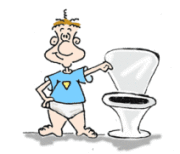Wednesday
Apr302014
Quick and Painless Potty Training in Ten Easy Steps
 Wednesday, April 30, 2014 at 11:48PM
Wednesday, April 30, 2014 at 11:48PM Two of my grandchildren have hit potty training age, so I’m reposting this very old post from my blogging past. This is the method I used for toilet training the last three of my children. The firstborn? She’s the kid I fussed over, bungling things in a big way, and from whom I learned the potty training lessons that I applied successfully to the other three.

- Wait until the child is two and a half. Or two and a halfish. If you live where there are four seasons, wait until the spring/summer/nice weather nearest the two and a half milestone.
- Make a trip to the store to buy several pairs of toddler underwear bearing the likenesses of things beloved to the trainee. Don’t substitute Pull-Ups. Pull-Ups, no matter how many gimmicks are added, work against successful toilet training.
- Don’t allow the precious panties to be worn yet. (Admiration, however, is encouraged.) Tell your trainee that these special unmentionables will be saved for the hallmark day they begin using the toilet (or a tree) like mommy and daddy do.
- Put the potty chair away. Go straight to more grown up receptacles like flush toilets. Unless, of course, you have a compelling reason to disregard this rule, like, “Potty chairs are so cute,” or “I really prefer dumping to flushing.”
- Wake up one day and say to yourself, “This is the day.” It’s best if this is a day with fine weather for staying outdoors, but you can also opt for a day when you feel like cleaning up puddles indoors.
- Dress the trainee in the cherished underwear and a t-shirt. Any more clothing is counterproductive.
- Go outdoors to play and wait for the first accident. Sympathize with the child over the wet underwear. Help your little one change to a new pair of similarly loved undies and have them put the old, wet ones in the hamper. Mention in passing that if they feel like they need to pee, they can tell you and you will help them go in the toilet so the beautiful undies don’t get wet. Resist the urge to say much more than this, and never, ever, ask, “Do you need to go yet?”
- Repeat step 7 as many times as necessary, for as many days as necessary. You will probably be surprised how few times step 7 needs to be repeated.
- If your child is male and you have a private yard, feel free to encourage the use of a tree or fence post instead of the toilet. This will make things easier for you and more fun for him. You can always civilize him later, if necessary. If you go this route, you may want to mention to the little guy that the parking meters on Main St. are not the same thing as fence posts. And while we’re on the subject of prudent warnings, also remind your potty trainee that the demo toilets in Home Depot are not for emergency use. With my own eyes I’ve seen the results of both these misunderstandings, and while they were certainly amusing, most of us would prefer to get this sort of shopping entertainment from other people’s children rather than our own.
- There isn’t really a step ten, but there is a money-back guarantee of success. If you follow these steps religiously and your child still goes to kindergarten in diapers, please write for a refund.



Reader Comments